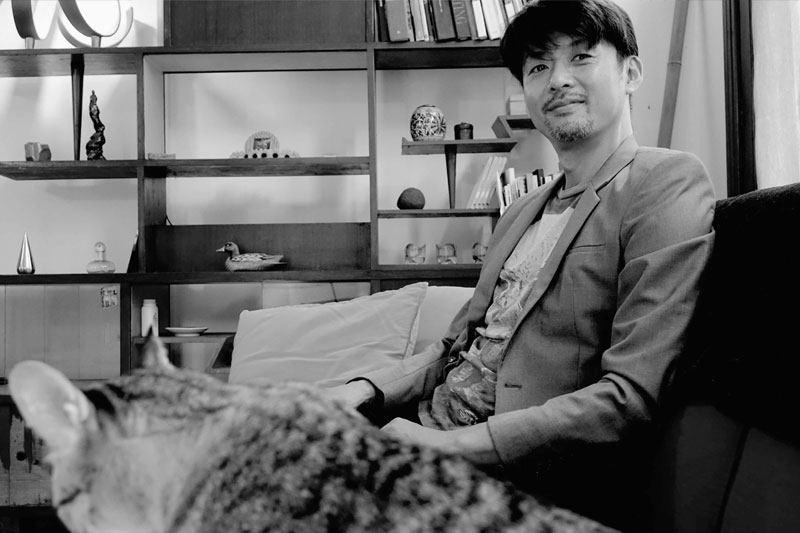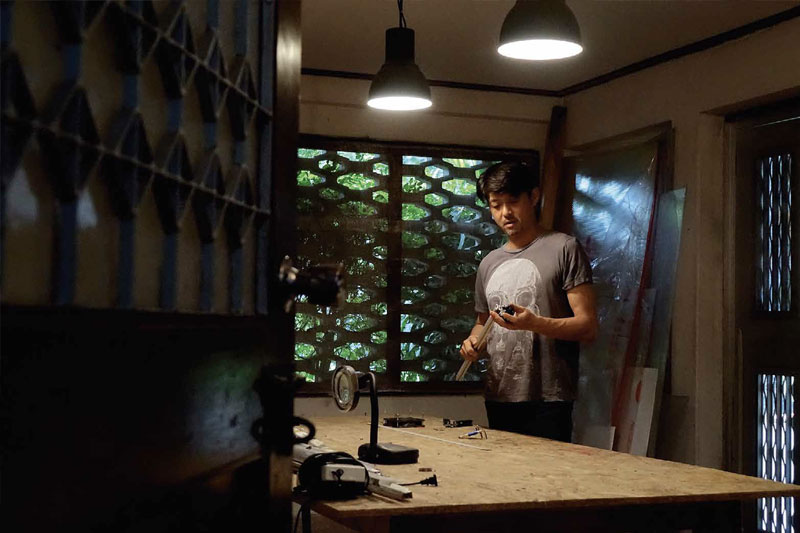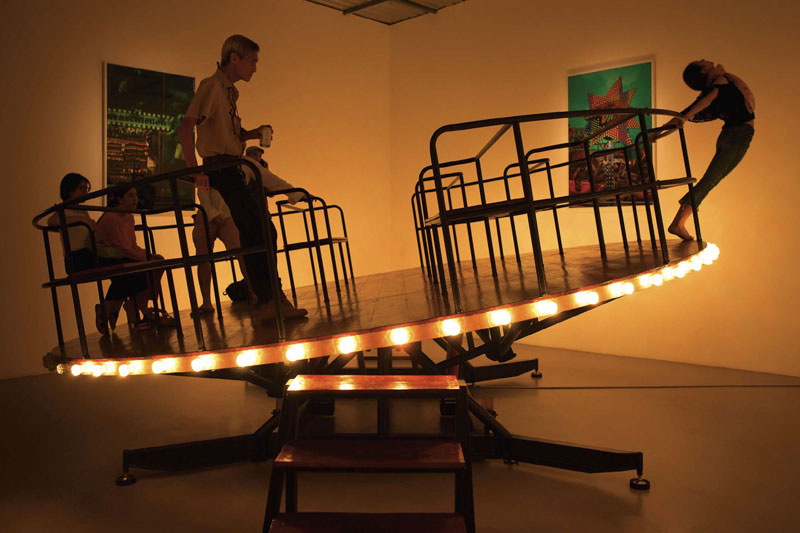
Projecting Light on Art
Artist Eiji Sumi shows us that the power of light lies not just in its ability to illuminate. It also has the power to make a social statement and to change perceptions.
Words: Korakot Punlopruksa, N Wright
Photos: Korakot Punlopruksa
A roommate’s innocent ‘theft’ of artist Eiji Sumi’s art work in his early career became a light bulb moment. What was considered a ‘hobby’ sat on the wall of a café in the Lower Eastside neighbourhood in New York, propped up together with a friend’s faith in the Japanese artist’s work. “Back then, I painted and my roommate stole my artwork and brought it to the café because he thought it was interesting,” Sumi relates. A few weeks later the café called, saying someone wanted to buy it.
“At first, I was unhappy he did this behind my back. But then it hit me: hey, people are interested in my work,” the Japanese artist now based in Bangkok recalls in wonderment. After studying art and design, his art career led to collaborative works commissioned by notable hotels like the Bowery and the Maritime Hotel in New York. His creative path included painting and photography, which evolved into his current specialisation in on-site large installations that interprets his visions of light, backed by deep science and innovative digital technology.
What got him noticed during his time in New York was one large scale work using bubble wrap, where the packing material became the canvas and digitised patterns formed in synchronicity to electro-music. Using a low-cost material and recycling it into complex art garnered him an invitation to be a lecturer in Bangkok’s Chulalongkorn University. The play of light, created and manipulated via a tablet, became another one of his success story.
“The bubble wrap projection was why ‘Chula’ invited me because not too many people were doing something like that, even in New York. If they did, it would be someone I know, a friend.” While his focus was on teaching art, he also created work that got noticed and shown around Bangkok.
More works making a statement came in the shape of an exhibit, “Quark,” where he used a reflective powder that created swirling patterns, shown at leading H Gallery in Bangkok. Art meets science as Sumi’s work created extragalactic effects. His art trajectory meant numerous exhibitions including art festivals in Bangkok and abroad. With work that’s been curated by notable people in the art world like Eric Shiner, Helen Homan Wu, Brian Curtin, Gridthiya Gaweewong, Keiichi Miyagawa, Lyno Vuth, Ni-kun, amongst others, Sumi modestly says, “I’m lucky to work with good curators.”

Now producing art projects using light and its many hues, Sumi combines science interwoven with personal expressions of social issues. He believes that in order to be relevant, a certain kind of focus is needed, especially for an artist whose world is ever changing. “For example, if Yayoi Kusama dis a painting like Picasso, people wonder, what happened to her? No one would recognise her artwork.” But installation artists like Jeff Koons and Damien Hirst can change everything because they are established artists. He points out that he’s not just a lighting artist, “because I do photography and virtual reality work.” But the constant themes revolve around social issues and urban development.
A recent installation, Play(e)scape features just that, from photography of theme parks to a see-sawing platform similar to yesteryear’s spinning playground equipment at Bangkok’s Gallery Ver. Although Play(e)scape derived from a localised Thai context, universal issues on power balance plays out with the combination of physics and politics. People step up and randomly plant themselves on the stage and coloured lights get activated by their movements. “The intention is that not everyone is equal to begin with in society; some people have power, and some have more power than others,” Sumi says, wanting dialogue to happen while moving around the platform. When balance is achieved and less see-sawing occurs, a singular colour is created and the message gets across.
He likens some of his work to being child-like. “I like my artwork to be simple so that children can connect to it, have a good time and get excited about it, get involved. It’s like my inner child coming out and making things. I know what children cannot practise and I am like an adult playing a role for children,” says Sumi, who was born in Tokyo and graduated from Rikkyo University.

He ensures that his work has a certain quality that has to be met.” If we make something and it’s mediocre work, the audience will know it and I will know it. so it is my challenge, I have to please myself first. Before showing to people, I want to see it first. Curiosity is the starting point. First I have to please myself, I have to wow myself for it has to worth something.” Sumi is about to launch an exhibit outside of Thailand, a fact he is coy about until details are finalised.
To make the concept accessible, he points out that art appreciation should be commonplace and transformative. “For me, art can be in an ordinary life. In a place where there’s a painting – when you are working from 9 to 5 and come home, when you see the painting you already detach from the normal daily life, the consuming part.” Detach from the routine in a regular life where art has a role, he suggests. Connect with this artwork and disconnect from the daily, consuming life, he suggests. He even voices hope that the simple task of cooking may result in an inspired recipe.
Meanwhile, Thai art is setting foot in the global art community as big international players are coming this year with the three biennale this year going into early February 2019. Sumi says it will be good for galleries since more new collectors and the general public might be more familiar with art. Art will be a part of a lifestyle, part of entertainment – just like watching movies. Currently, art is quite exclusive among the general Thai audience.
He presses the point that art plays a role to stimulate us. When we look at it, Sumi says oru brain refreshes, resets. “The DNA, or brain cells divide when it gets stimulated, it makes us younger.” What to look for then where art is concerned? “I guess it depends on your interest, but what I look for is stimulation, brain nutrition and having intellect thrive. Good art has elaborate elements and it gives us a mysterious energy, of power, to rejuvenate our minds.”

เรื่องทั้งหมดเริ่มจากเพื่อนร่วมห้องเจ้าปัญหาในนิวยอร์ก “ขโมย” งานศิลปะของไอจิ ซูมิ ไปแขวนไว้ผนังของร้านคาเฟ่แห่งหนึ่ง ไม่กี่อาทิตย์หลังจากนั้น ซูมิก็ได้รับโทรศัพท์แจ้งว่า มีคนสนใจซื้อผลงานของเขา แรกทีเดียวซูมิรู้สึกแย่ที่เพื่อนคนนั้นทำไปโดยไม่บอกกล่าว แต่พอคิดดูอีกที เออ…มีคนสนใจงานของเราด้วย
หลังจากเรียนศิลปะและการออกแบบซูมิได้ร่วมงานกับโรงแรมที่มีชื่อเสียงอย่าง Bowery และ Maritime ในนิวยอร์ก ร่วมสร้างงานศิลปะที่ผสมผสานการวาดภาพและภาพถ่ายเข้าไว้ด้วยกัน เป็นงานจัดแสดงขนาดใหญ่ที่ตีความผ่านแสงและเงา ผ่านวิทยาศาสตร์และเทคโนโลยีดิจิทัล
งานที่ได้รับความสนใจมากที่สุดของเขาในช่วงที่ใช้ชีวิตในนิวยอร์ก คืองานที่ใช้บับเบิ้ลหรือพลาสติกกันกระแทก แล้วฉายลวดลายสอดประสานกับดนตรีอิเล็กทรอนิกส์ จนทำให้ซูมิได้รับเชิญให้เป็นอาจารย์ที่จุฬาลงกรณ์มหาวิทยาลัย
ซูมิทำงานสอนระดับมหาวิทยาลัยไปด้วย แต่ก็ยังสร้างงานศิลปะอยู่บ่อยครั้ง เช่น นิทรรศการ “Quark” จัดแสดงที่ H Gallery กรุงเทพฯ เขาใช้ผงสะท้อนแสงสร้างเป็นรูปแบบหมุนวนเกิดเป็นสีสันเหมือนอวกาศและยังมีงานจัดแสดงในเทศกาลศิลปะอีกมากมายในกรุงเทพฯ
การทำให้ศิลปะอยู่ในกระแสจะต้องมีจุดสนใจ โดยเฉพาะงานศิลปะในโลกที่เปลี่ยนแปลงไปอย่างรวดเร็ว งานศิลปะของซูมิแสดงถึงแง่มุมทางวิทยาศาสตร์และประเด็นต่างๆ ในสังคมไปพร้อมกัน ซูมิเลือกที่จะใช้การถ่ายภาพและศิลปะเสมือนจริงเพื่อวิพากษ์ประเด็นในสังคมและการพัฒนาของชุมชนเมือง
Play(e)scape เป็นงานจัดแสดงศิลปะล่าสุดที่เล่นประเด็นเรื่องความสมดุลเชิงอำนาจ โดยผสมผสานฟิสิกส์และการเมืองไว้อย่างลงตัว ผู้ชมงานศิลปะจะขึ้นไปบนเวที การเคลื่อนไหวของร่างกายจะทำให้ไฟหลากสีฉายออกมาเพื่อสะท้อนว่าแต่ละคนไม่ได้เกิดมาเท่าเทียมกัน คนคนหนึ่งอาจมีอำนาจน้อยหรือมากกว่าคนอีกคนหนึ่งเสมอ แต่เมื่อไรที่เกิดความสมดุลขึ้น แสงของไฟจึงจะฉายออกมาเป็นสีเดียวกัน
ซูมิอธิบายว่า เขาต้องการสร้างงานศิลปะที่แม้แต่เด็กเล็กก็สามารถเข้าถึงได้เหมือนกับเป็นการดึงตัวตนความเป็นเด็กในตัวเขาออกมา เพราะซูมิรู้ว่ามีบางอย่างที่เด็กไม่สามารถทำได้ ในฐานะผู้ใหญ่ เขาจึงอยากทำสิ่งนี้แทนเด็กๆ
แน่นอนว่างานของซูมิต้องมีมาตรฐาน ความท้าทายคือการที่เขาต้องทำให้ตัวเองพอใจกับงานก่อนจึงจะจัดแสดงต่อสาธารณชน ซูมิเห็นว่าการเสพงานศิลปะควรเป็นเรื่องธรรมดาสามัญและก่อให้เกิดการเปลี่ยนแปลงได้ งานศิลปะควรมีหน้าที่ช่วยทำให้เราตัดขาดจากชีวิตประจำวันที่ยุ่งยากและยุ่งเหยิง ทำให้ทุกคนตัดขาดจากโลกแห่งความเป็นจริงและเป็นหนึ่งเดียวกับศิลปะ
ศิลปะกำลังกระจายตัวและเป็นส่วนหนึ่งของวิถีชีวิต โดยเฉพาะเมื่อจะมีการจัดงานเบียนนาเล่สามงานในประเทศไทยจนถึงช่วงเดือนกุมภาพันธ์ปีหน้า เป็นโอกาสอันดีที่บุคคลทั่วไปจะได้มีโอกาสสร้างความคุ้นชินกับงานศิลปะ และทำให้งานศิลปะกลายเป็นความบันเทิงอีกแขนงที่ไม่ต่างจากการชมภาพยนตร์สักเรื่อง
ซูมิยังย้ำอีกว่า เซลล์สมองของเราจะแบ่งตัวเมื่อได้รับการกระตุ้น ทำให้เราอ่อนเยาว์ลง หน้าที่ของศิลปะคือการกระตุ้นผู้ชมซึ่งถือเป็นอาหารสมองที่ให้พลังงานอันลึกลับ ให้เราได้สัมผัสถึงพลังอำนาจและทำให้จิตใจของเราอ่อนวัยกระปรี้กระเปร่าอีกครั้ง
